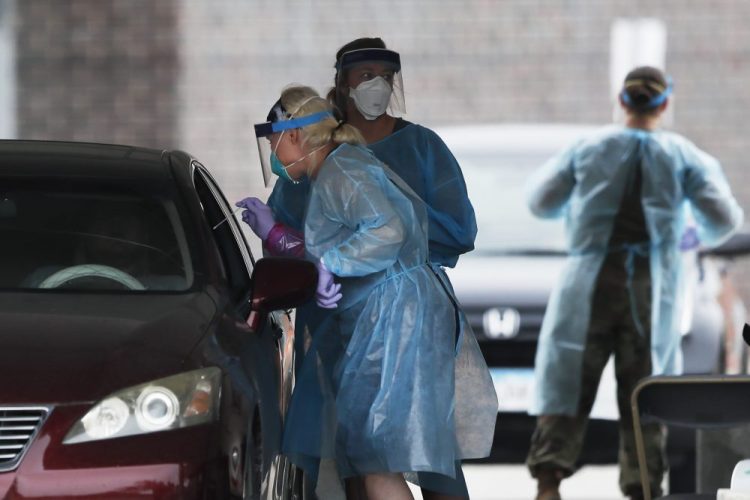WASHINGTON — The United States’ coronavirus cases are rising again, driven by rapid transmission in Midwestern states and sparking fears that a forewarned wave of infections this fall and winter has begun.
For almost a month, new U.S. cases have been trending upward. On Monday, 17 states hit new highs in their seven-day average of case counts, and eight of those states hit records by Tuesday afternoon.
The rising numbers are especially concerning because they set the stage for an even greater surge this winter, when the virus will be helped by drier conditions and people spending more time indoors. The upward trend comes before the increased mingling of people expected to arrive with Halloween, Thanksgiving and Christmas.
The virus has become especially rampant in Midwestern states after dominating America’s coastal and urban areas this spring, according to data tracked by The Washington Post.
It is unclear what factors are driving the recent increase – whether it is the long-feared winter effect already taking place or the resumption of business and schools, or simply fatigue and people letting down their guard on social distancing efforts.
Because of day-to-day fluctuations in the reporting of cases, experts often look at the seven-day average of case counts to accurately spot trends.
In 40 states, cases are higher than the week before.
Indiana, Minnesota and North Dakota have set new average highs for cases each of the past eight days. More than a dozen other states have set new average highs in recent days.
“A lot of the places being hit are Midwest states that were spared in the beginning,” said William Hanage, a Harvard University infectious-diseases researcher. “That’s of particular concern because a lot of these smaller regions don’t have the ICU beds and capacity that the urban centers had.”
The District of Columbia and some Northeastern states – including Connecticut, New Jersey and New York – are beginning to see case counts creep back up.
Hospitalizations for COVID-19, the illness caused by the novel coronavirus, have begun rising in almost a dozen states – including Ohio and Pennsylvania – raising the worry that increasing death counts will soon follow.
On Tuesday, Ohio Gov. Mike DeWine, a Republican, warned in a tweet, “In all likelihood, things will get worse before they get better. This virus is sneaky and cunning and won’t give up. It has a mind of its own.”
Anthony Fauci, director of the National Institute of Allergy and Infectious Diseases, said on Monday he hopes the numbers “jolt the American public into a realization that we really can’t let this happen because it’s on a trajectory of getting worse and worse.” In a CNN interview, he called the rising numbers “the worst possible thing that could happen as we get into the cooler months.”
At least 215,000 people in the United States have died of COVID-19, according to an analysis by The Post.
One prominent model – by the Institute for Health Metrics and Evaluation at the University of Washington – forecasts that U.S. deaths could rise to more than 394,000 by Feb. 1.
The U.S. trajectory highlights the need for action by federal and state leaders as well as everyday Americans before transmission grows out of control, experts said.
Many experts, including Fauci, have emphasized that such actions don’t have to be as drastic as the shutdowns the country saw in the spring. Public health experts say that if Americans adopt even the simplest measures discussed for months, it could make a big difference. That includes universal mask-wearing, social distancing, hand-washing and avoiding crowds.
“The earlier you do it the better, because it requires less time and less severe interventions,” Hanage said. “The later you wait, the more difficult it becomes because of the exponential growth of the virus.”
Other countries have seen alarming increases in recent weeks, including England, France, Germany and Italy. European leaders have told their residents to brace themselves, warning of a “decisive moment” and “perilous turning point.”
The warnings have come in contrast to President Trump’s downplaying of the severity of the U.S. outbreak, which has been the worst in the world by many measures.
In recent weeks, U.S. public health experts have grown concerned that a sense of fatalism and resignation about the virus is setting in among the American public.
“My biggest concern is around the continued vigilance that prevention requires – the distancing, masking, avoidance of crowded indoor areas, etc. The fatigue factor sets in,” said Saskia Popescu, an epidemiologist at the University of Arizona.
The intensifying politicization of public health efforts amid the election has not helped, Popescu said.
“Political leaders pushing that we’ve controlled the outbreak encourages people to relax their prevention efforts,” Popescu said.
Send questions/comments to the editors.



Success. Please wait for the page to reload. If the page does not reload within 5 seconds, please refresh the page.
Enter your email and password to access comments.
Hi, to comment on stories you must . This profile is in addition to your subscription and website login.
Already have a commenting profile? .
Invalid username/password.
Please check your email to confirm and complete your registration.
Only subscribers are eligible to post comments. Please subscribe or login first for digital access. Here’s why.
Use the form below to reset your password. When you've submitted your account email, we will send an email with a reset code.